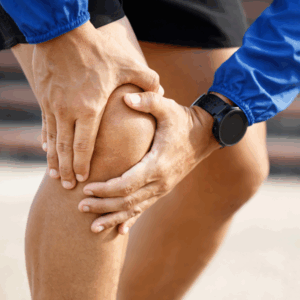May 1, 2025
5 Common Spring Injuries and How to Avoid Them: Tips from Your Orthopedic Surgeon
As the weather warms up, many people head outside for sports, yardwork, and other activities. But spring isn’t just a time for blooming flowers—it’s also prime season for injuries. As an orthopedic surgeon, I see a spike in injuries every year around this time. After a long winter, kids are beginning spring sports, and people are excited to get moving again, but if you’re not easing into it, your body may not be ready.
Many injuries can be prevented with proper training techniques, stretching, hydration, and consistent cross-training. Time spent focusing on strength, flexibility, and agility in both the off-season and your season may help prevent injuries and future pain.
Here are five most common spring injuries and how to help prevent them.
-
Sprained Ankles
Whether it’s from running, hiking or playing sports, ankle sprains are one of the most common injuries in the spring. A sudden twist or misstep can stretch or tear the ligaments in the ankle.
How to prevent it: Wear supportive shoes and warm up before activity. If you’re walking or running outdoors, watch  out for uneven ground or wet surfaces. Start slow if you’ve been inactive during the winter.
out for uneven ground or wet surfaces. Start slow if you’ve been inactive during the winter.
-
Knee Injuries
Spring sports like soccer, baseball, running, and tennis can lead to knee problems—especially if the
muscles around your knees are weak or tight. ACL tears, meniscus injuries, and tendon strains are common.
How to prevent it: Stretch your legs before and after activity. Focus on strengthening your thighs and hips to support the knee. If you feel pain or swelling, stop and rest.
-
Shoulder Strains
Yardwork, gardening and swinging sports like golf or baseball can put a lot of stress on the shoulders. Lifting, reaching, or throwing can strain the muscles and tendons around the joint.
How to prevent it: Take breaks and don’t overdo it, especially with overhead motions. Use proper lifting techniques and avoid carrying heavy items with one arm. Build strength and flexibility with light shoulder exercises.
-
Back Pain

Suddenly jumping into raking, planting, or outdoor workouts can cause back strain, especially if you use poor posture or lift incorrectly.
How to prevent it: Stretch your back, hips, and hamstrings before yardwork. Use your legs to lift, not your back. Take breaks and switch positions often to avoid staying in one posture too long.
-
Concussions
Contact sports like lacrosse, soccer, and football can lead to head injuries, especially among kids and teens. Even a fall off a bike or scooter can result in a concussion.
How to prevent it: Always wear a properly fitted helmet when biking, skating, or riding a scooter. In sports, follow the rules and use proper techniques to avoid dangerous collisions. If someone hits their head and shows signs like confusion, dizziness, or nausea, they should be checked by a medical professional.
If you do get hurt, see a specialist if pain, swelling, or other symptoms last more than a few days. Don’t ignore an injury or try to push through it. Getting care early can prevent injuries from getting worse and keeping you out of the activity you enjoy longer.
When to See an Orthopedist
Not every ache or pain needs a specialist, but some signs mean it’s time to see an orthopedic provider. If you’ve had an injury and the pain doesn’t improve with rest, ice, or over-the-counter medications after a few days, it’s worth getting it checked out. Swelling that doesn’t go down, limited range of motion, or a joint that feels unstable can all be signs of a more serious issue like a tear or fracture.
You should also make an appointment if you hear a pop at the time of injury, can’t bear weight on a joint, or if pain keeps returning every time you try to be active. These are all signs that something might not be healing properly—and delaying care could make things worse.
Orthopedic surgeons aren’t just for surgery. We can offer guidance on injury prevention, physical therapy, bracing, and other treatments to safely get you back to doing what you love.
Spring is a great time to be active, just make sure your body is ready.
Foundation Orthopedics is here to keep you in the game.
 Dr. Robert Davis is a board-certified orthopedic surgeon at Foundation Orthopedics in Nashua, New Hampshire.
Dr. Robert Davis is a board-certified orthopedic surgeon at Foundation Orthopedics in Nashua, New Hampshire.

